 FS Suffren, FS Duquesne 1962-2008
FS Suffren, FS Duquesne 1962-2008
The Suffren class were two missile fleet escorts of the French Navy, assigned to the new French aircraft carrier groups based around Foch and Clemenceau. They had to protect the fleet against air, surface and submarine threats and first French ships specifically designed as guided missile destroyers. Ordered in 1960, budget pressure from deterrence allocations limited the class to just two. The lead ship, Suffren, entered service in 1967, Duquesne in 1970 and they remained in service until the 2000s, replaced by the Horizon class. They were classed as Frigates despite their destroyers pennants and most publications considering them as such. #frenchnavy #coldwar #suffren #guidedmissiledestroyers #missilefrigates #masurca #malafon #marinenationale #exocet
In 1960 the new aircraft carriers of the French Navy, the Clemenceau class were about to be completed, the first in 1961, second in 1963. As escorts, they had either the T47 (Surcouf) or T54 (Duperré) class destroyers, and neither of them was armed with missiles for a long range defence against threats, which, even though France left NATO since 1958, remained aligned in an anti-Soviet stance as the most likely adversary. The naval staff considered the threat posed by their long range bombers armed with equally long range antiship missiles.
A quadruple effort was decided in 1960:
-Develop a national long range SAM (Which became the MASURCA, studied from 1948 but really introduced in 1966)
-Modernize existing destroyers
-Modernize cruisers (for budgetary reasons, only Colbert was)
-Built new dedicated guided missile destroyers
For the first point, see later. For the second point, this effort was made in the 1970s and not all destroyers received a SAM system.
Development
The need for a CBG missile escort
It was a finance law, voyed in Parliament on December 30, 1959 which gave Suffren its legal existence. But still three years of studies for the precise definition of the underlying military program were necessary to get a building project with precised plans. 29 months later studies concluded by acceptation of the design, and supply materials and placing orders with the initial machining work starting in Lorient and on December 21, work started at DCAN Lorient (Naval Yard) under the provisional name FLE 60 (see later).
The Question of Missiles
For the last point, the naval staff started with a blank page as they wanted a ship large enough to carry out the defence of a battle fleet in three axles, air/surface/underwater, all three addressed by missiles. If the MASURCA was only envisioned against distant air targets (and large soviet cruise missiles), the second, MALAFON, was to be both usable against ships and submarines, albeit indirectly and in a limited way as it carried like the ASROC a torpedo and was relatively short range.
France at the time also worked on a long range sea-skimming missile, with a program initially planned for the new Suffren class, and started in 1967 at Nord, entering service in 1971.
But before that, the Navy operated already the Nord AS.12, which entered service in 1960 in the air-to-surface role from the Clemenceau class carriers, but still not on ships. This started only by 1966 with an evaluation of the SS.11(M) and SS.12(M) on the La Combattante class FAC. In 1966, the Libyan Navy followed by other navies ordered these, but it was never deployed on the new destroyers as judged of insufficient range (7,000-8,000 m) at 370 km/h guided from its platform to the target via wire MCLOS. This made the carrier way too exposed to SAMs and AA fire.
Meanwhile the design team of DCN (Directorate of Naval Construction) progressed on the design, centered around two weapons systems, the MASURCA and MALAFON, which ended with a ships that was superficially similar in concept to the British Type 82 destroyer. They were ordered in 1960, insterted in the new naval policy of deterrence/intervention/defence policy after the election of Charles de Gaulle as president.
Designation: Cruisers, Frigates or Destroyers ?
In 1960 they were designated as cruisers. But later French designation in 1963 was frégate lance-engins (FLE 60) or “craft launch frigate”. They are still considered destroyers by most publications, given “D” in their pennant. Later they were re-designated “frégates lance-missiles” (FLM 60) or “missile launching frigates”. We will follow there the general trend, and consider them as Frigates. Today’s frigates could be absolutely massive and should be assimilated to destroyers, so this classification always had been artificial. Let’s remember that both the USS Long Beach and the Leahy class were classified initially also as Frigates, re-classed as cruisers in the 1970s.
Construction, and curtailing of the class
The end result of the FLE 60 design from mid-1960 to December 1962 when D602, the first of the two, were ordered at Brest NyD was a very large ship, close to 6,800 t (6,670 long tons) fully loaded and close to 160 m or 520 feet in lenght, so closer to a contemporary Leahy class frigate indeed. Like these, they were “single ender”, with a single SAM aft, but also armed with guns. They also had the best radar and sonar suite ever put on a French escort so far, and becalme the largest French ships after the completion of the Clemenceau class. Construction at Brest and Lorient took between five and seven years, which was also exceptionally long and reflected design changes and their complicated setup as “firsts”. The cost rose accordingly at more than twice the cost of T47/53 destroyers, which also did not helped their cause in a budget-strapped context* and further ships in the class were not ordered.
*The deterrence policy decided by De Gaulle had a detrimental effect on the fleet at the time, draining resources and ending or delaying many projects. As a result, the “plan bleu” was setup after the departure of De Gaulle from presidency in 1969 to refund the navy and decide of a massive naval rearmament.
The fact the Suffren class lacked any potent anti-ship long range missile was a considerable problem, and its SAM capability was equally limited, with the MASURCA was considered second line, as the incoming soviet bombers were tasked to be shot down by the carrier’s F8N Crusaders anyway at long ranges.
Design of the class
Hull and general design
The Suffren class measured 157.6 metres (517 ft 1 in) overall, 148 m (485 ft 7 in) between perpendiculars. The 15.54 m (51 ft) beam made for an ideal 1/11 ratio for top speed, on a maximum draught of 7.4 m (24 ft 3 in) which did not compromise buoyancy and thus, stability. Final displacement was a nominal 5,090 tonnes (5,010 long tons), 6,090 tonnes (5,990 long tons) fully loaded. By 1990 after several refits and modernizations/additions, this rose respectively to 5,335 t (5,251 long tons) standard, 6,780 t (6,670 long tons) full load.
Their complement was 355 sailors, and that included 23 officers. For service they carried (in 1985) a 8,3 m cutter, one 9m utility LCPS, a 7m whaler, and 10 seats dinghy, 6 seats dinghy and this was changed in 2000.
The hull received extra stabilization measures to be better weapons platform, with three pairs of non-retractable fin stabilisers in addition to two counter-keels. With their elegant lines and fine clipper bow, transom stern, plain flanks, they were considered extremely seaworthy vessels. Their silhouette was somewhat marred by the presence of a conspicuous radome, protecting their main surveillance radar. This was a trend, see HMS Bristol and closely related Tromp class.
The ships were peculiar with a classic forward section and superfiring main artillery, a stepped bridge and massive radome, then a tall “mack’ combination of mast and funnel, the Malafon launcher on deck, a rear structure with FCS radars, and then the twin-arm SAM launcher on a lower quartedeck, cut out to operate the VDS sonar.
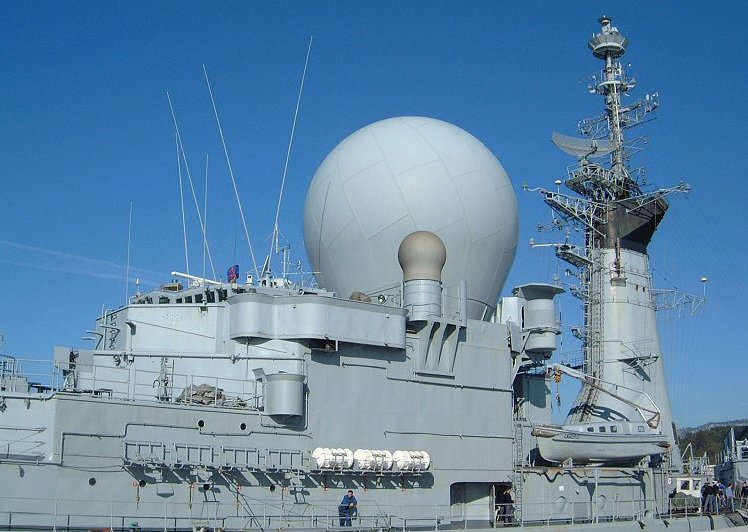
The other sonar fixed in the bow made a distinctive bulge. They proved that a 6,000 tonnes ship could carry the relatively large Masurca system, until it was ported on the larger FS Colbert, a 10,000 tonnes cruiser during refit. Later they innovated as being the world’s first ships to operate the Exocet MM38 missiles. It entered service just as FS Duquesne was accepted into service.
However one main critic was their lack of helideck, for a more efficient ASW. There just was not room for it after it was decided to go with a twin gun forward configuration, aft SAM.
Powerplant
At that stage it was not envisioned to gave them nuclear propulsion as the first naval reactors intended for the new Le Redoutable class SSBNs were considered not suitable to be adapted in a ship yet, and not ready anyway. Instead, the ships would be powered by four Indret multi-tube boilers under fully automatic control from a central console. Their working pressure was 45 kg/cm2 (640 psi) at 450 °C (842 °F). Steam was injected into two Rateau geared turbines of the double-reduction type, the largest designed for a French vessel after those of the Clemenceau, driving two propellers shafts. Total output was estimated at 54,100 kilowatts (72,500 shp).
In complement, to power both the sensors and armament when at anchor and machines cold, they had a set comprising two Bréguet 1,000 kW turbochargers plus three 480 kW MGOV12ASHR diesel alternators which ensured a total output of 3,440 kW electrical power with a tailored high voltage network.
Top speed was 34 knots (63 km/h; 39 mph), seen as necessary to evade an incoming missile at the time, and keep up with the carrier battle group. Range was 5,100 nautical miles (9,400 km; 5,900 mi) at 18 knots (33 km/h; 21 mph) which was considered enough either for their mid-Atlantic or Mid-Mediterranean deployments. They still could cover 4,500 km (2500 nm) at 29 kts. They carried 800 t of oil and 50 t of drinking water.
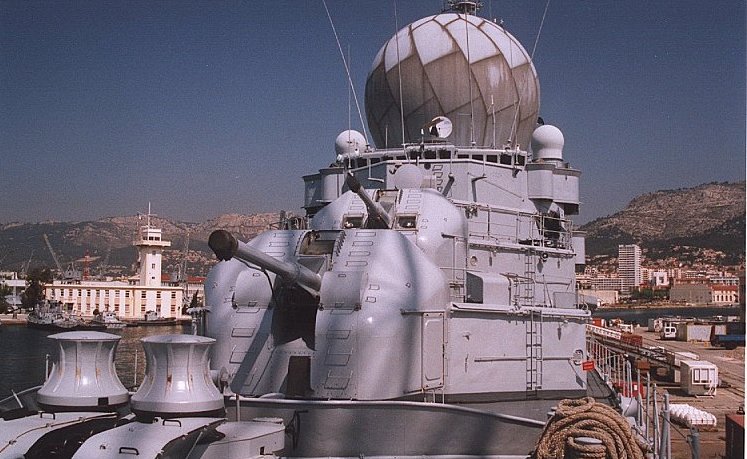
Armament
Main: 1×2 MASURCA SAM
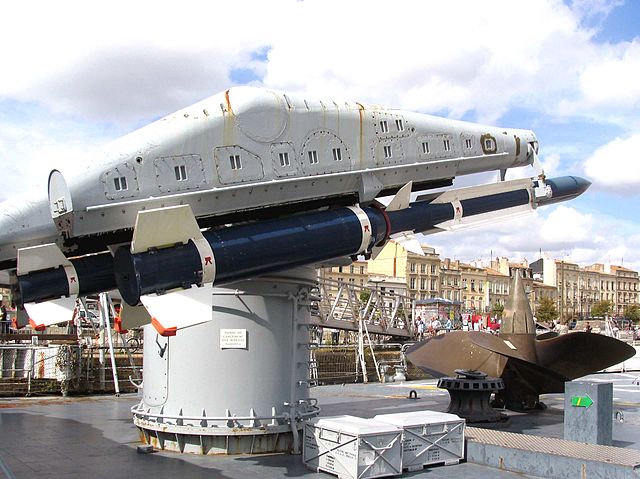
The Suffren class had a twin launcher on the quarterdeck aft, wit a twin-arm medium range Masurca surface-to-air missile and 48 missiles in store, reloaded via a conveyor belt located in the upper hull. The first model used was the Mark 2 Mod 3 Masurca missile (range 30 nmi (56 km; 35 mi) with a 98-kilogram (216 lb) warhead). The name was an acronym, (MArine SURface Contre-Avions) “Naval surface anti-aircraft” (system) developed by Matra. To have more information on the Masurca, check the Colbert article.
The two aft Masurca guidance groups each including a DRBR-51 illuminator radar telepointer assembly, dish-shaped.
ASW: 1x MALAFON ASWM
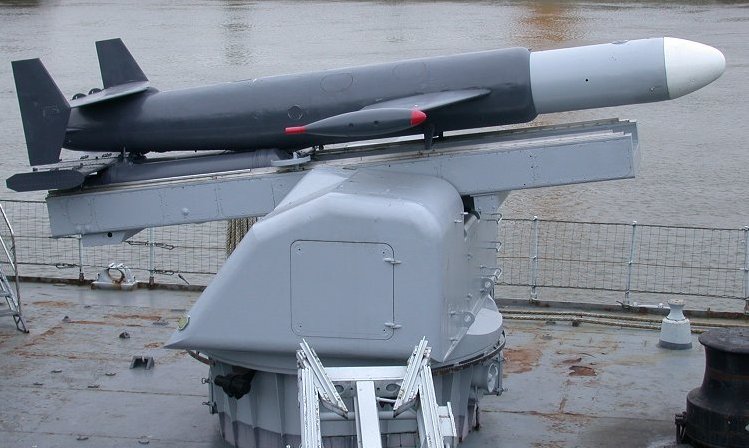
The frigates also mounted a Malafon anti-submarine missile system. Each ship carried 13 missiles and the magazine was situated in the aft deckhouse.
In short: Single launcher arm , hold with 13 spare missiles, radar-guided during initial flight. Payload 450mm (18 in) L4 torpedo, later L5. The missile accelerated to 830 km/h (520 mph), flew at 100 metres (330 ft) altitude and corrected trajectory via radio control up to 13 km (8.1 mi). The dropped homing torpedo swam at 30 knots (56 km/h; 35 mph) over 5 km (3.1 mi) to the target.
See the Malafon section on the La Galissonière destroyer for more info.
ASW: Torpedoes
The Suffren lacked torpedo tube banks unlike previous destroyers and instead innovated in having four catapult launchers, with the L5 torpedo. Two were placed on each side of the ship, in the main deckhouse between mast and bridge. Ten torpedoes were carried, and this system was a first. With the advent of homing torpedoes having a travering bank was now superfluous and most navies chosed that path as this made the loading process easier inside. They were the first French warships to have such launchers, adopted for later classes.
The L5 Torpedo took advantage of 4x better sonar ranges and three models were developed, the Mod 1, Mod 3 and Mod 4. Mod 1 was carried at first, later upgraded by mod.4. They could operate at depths of 1,800 feet (550 m) if needed, and were powered by a Silver-zinc Battery to 7,700 yards (7,000 m) at 35 knots for Mod.1, later 10,000 yards for Mod.4 and carried a 440 lbs. (200 kg) HBX-3 or TNT warhead. It was also capable of engaging a surface target.
Artillery: 2x 100mm
The frigates had two single mounted 100 mm (3.9 in) Modèle 1953 naval guns in superfiring position on the centreline. Later upgraded they were upgraded to thefully automated Modèle 1964. These dual-purpose guns were capable of lobbying an anti-surface shell at 9 nmi (17 km; 10 mi), each coming with a 13.5 kg (30 lb) warhead. In AA fire, thye fired an anti-air fuse shell at 4.4 nmi (8.1 km; 5.1 mi) but fire at 80 rounds per minute.
There was a CTMS (multisensor fire control) coupled with DRBC-33A radar and a Piranha II IR deviation meter plus TV camera to guide the 100mm guns as well as two DMA-a Panda optical stations.
At some point were added four single 20mm/70 Mk 4 Oerlikon for close defense in 1990 (see later).
Sensors
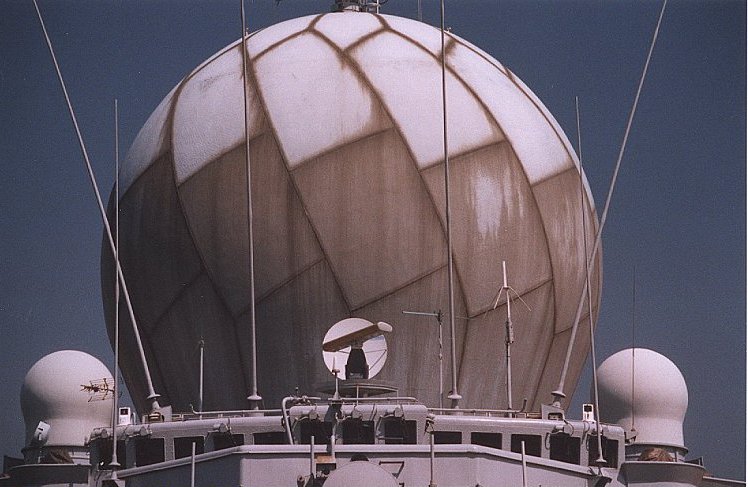
The DRBI-23 three-dimensional radar is the main means of detection. The mobile part of its aerial weighs 28t. It is sheltered by a spectacular fiberglass dome 11.25 m in diameter, protecting it from smoke, spray and wind.
-DRBI 23 radar: 3D, Air search/tracking, housed in a massive radome atop the main bridge.
-DRBN 32 radar: Navigation radar
-DRBV 50 radar: Surface monitoring and navigation radar
-2x DRBR 51 radars: For controlling
-DRBC 32A radar:
-ARB 17: Radar detection system
-DUBV 23 hull-mounted sonar:
-DUBV 43 towed variable depth sonar:
-Syllex chaff system:
-SENIT I: Tactical Data fusion system, coordinating sensors with displays.

Conways depiction of the ships in 1970
⚙ specifications in 1967 |
|
| Displacement | 5,335 t standard, 6,780 t full load |
| Dimensions | 157.6 x 15.54 x 7.4 (517 ft 1 in x 51 ft x 24 ft 3 in) |
| Propulsion | 2 shafts, 4 geared turbines, 4 boilers 54,063 kW (72,500 shp) |
| Speed | 34 knots (63 km/h; 39 mph) |
| Range | 5,100 nmi (9,400 km; 5,900 mi) at 18 knots (33 km/h; 21 mph) |
| Armament | 1×2 (48) Masurca SAM, 4x L5 ASW torpedoes, 1x Malafon ASWM, 2× 100 mm turrets, see notes |
| Sensors | DRBI 23, DRBV 15, DRBC 33, DRBN 34, DRBR 51 |
| Crew | 355, including 23 officers |
Modernization
In 1977-1979, four MM38 Exocet canister were fitted on each ship, located on the upper deck house aft of the Malafon launcher facing starboard and port quarter aft.
The Masuraca system was also upgraded in 1982–1985. 1985 saw Duquesne replacing its DRBV 50 rada for the DRBV 15 and Suffren in 1989–1990. Both had their DRBC 32A gunfire control radar replaced with the DRBC 33A. The Syllex chaff launcher was replaced by the Dagaie coupled with a Sagaie electronic countermeasures system. At the same time were also mounted four 20 mm (0.79 in) cannon each side abaft the DRBC 33A radar for asymetric threat, and Duquesne had the same modifications in 1990. Later this was changed for two 20 mm F2 cannons and four 12,7 mm (0.5) cal. Browning HMGs.
 FS Suffren (1967)
FS Suffren (1967)
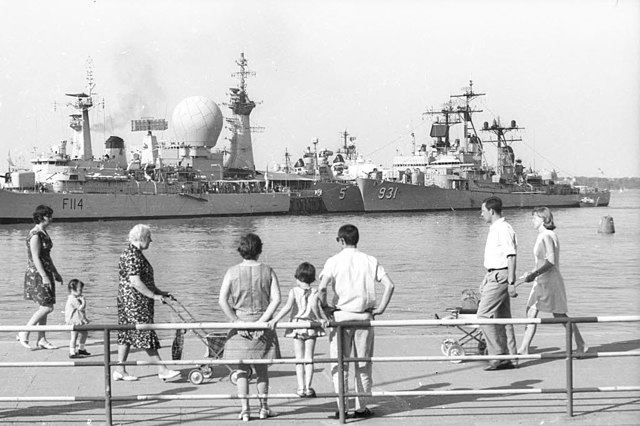
Suffren at the Kiel Week 1970
The time the frigate spent from completion to effective service was almost two years. Indeed when Suffren was launched on May 15, 1965, in the presence of a large audience and with some of its personnel on board, five more months were needed to install her armament for testing. By October 23, 1965, she was officially completed, but not yet commissioned. On October 23, Captain Alain Cussac became her first commander, and her armaments started to be tested. She made her sea trials off Toulon. Masurca and Malafon are installed but not her VDS and work went on at Lorient all along 1966.
On February 4, 1967, Captain Philippe de Gaulle (son of the famous General) took command and from February to September 1967, the last equipment installed followed by new extended and official sea trials in the Mediterranean. On October 1st she is considered ready for a short test cruise and by October 8 to November 17 she was in final weapons quialifications, for her main artillery, Malafon and torpedoes, then Masurca SAM. When Suffren left Lorient on October 9, 1967, two years passed, between the dockyard, basin and at sea, seeing turning teams from DCAN engineers, Indret, Guérigny and Ruelle, national private companies and well as British, American and other foreign companies. All this time her crew and officers participated in the development, testing, assessment and maintenance phased of the ship.
On November 18, she departed from Toulon for her first endurance, shakedown cruise, in which she stopped at Dakar, Rio de Janeiro, Recife, Las Palmas, Lorient and back to Toulon.
In January-June 1968 she was in posts fixes and more trials of her weapons and electronics and by March 30 Captain Jean Tardy took command. In April she was homeported to Brest, and in May 4 made aother weapons firing trials campaign, followed by her first “cold cruise” to Reykjavik, crossing the Polar Circle to Jan Mayen. Technically her true Admission to active service dates July, 20, 1968. Assigned to the Atlantic fleet she started escorting the Clemenceau class carriers, made her spring cruise with the fleet followed in December by “Fair Game” NATO exercise and in February 1970 Exercise Finisterex VIII. From April to September she made various training sorties with the Atlantic Fleet and carried the rear admiral, as commander, Atlantic Escort fleet, with Chapeau Rond ASW exercises (April) and Datex AA exercises (May) in the Bay of Biscay, and a summer tour with combined exercises. She visited Amsterdam, Goteborg, Kiel, La Pallice.
By October 1st 1970, this was the start of her first major refit in Brest. It ended in February 1972 with the new V43 towed sonar, new fire control radar for the 100 mm, chaff launchers and jammers. She carried out her post-refit trials, and in May-July worked at the Fleet Training Center, stopped in Naples (June), Antwerp (October) and took part in the Toulon naval exhibition (October), Nemo exercises/Passex with the USN in November, and French exercizes Sterne and Toucan VI in December.
In 1973 more exercises, a stop at Cádiz (February), Portsmouth (March), a short overhaul at Brest, Electronic warfare tests, stops at Freetown (November), La Praya (December) and Santa Cruz de Tenerife.
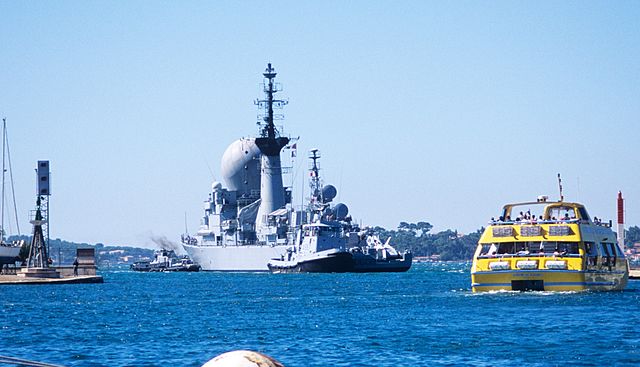
In Feb. 1974 she took part in the Franco-Spanish exercise Escuadras 74, then Inès II, stopped at Cádiz, Santa Cruz de Tenerife and La Coruña and in September-October had a small refit at Brest.
In November with the Atlantic Squadron she escorted the new SSBN Le Terrible with the President of the Republic on board, stopping at Dublin and Santander.
In February-July 1974 she took part in Mission Thétis with Kersaint, stopped at Dakar, Libreville, Crossed the equator on February 27, stopped in Cape Town, Port des Galets, Mahe, Djibouti, Bander Abbas, Bushir, Damman, Abu Dhabi, Dubai and the Hanish Islands before crossing the Suez Canal, stopping at Augusta and Cadiz, then back to Brest. By September-October she was in IPER (major maintenance).
By Early November she was homeported to Toulon, following the Clemenceau class, mediterranean fleet. She took part in Iles d’Or exercise. In 1976 she stopped in Cannes, Saint-Tropez, Sête, Valence, Alexandria, Palma de Mallorca, Cartagena, Piraeus. In May-June she sortied to the Eastern Mediterranean, stopped at Alexandria and September-October saw her in ex. NATO Team Work and then the Franco-Spanish exercise Faron 76 before an IPER in Toulon until May 9, 1977 with overhaul of her HP turbines.
in June she was pat of te Zorba group outing, Eastern Mediterranean, Athens and in September-October, Mission Mustapha. In November, the Iles d’Or Exercise. In 1978 she made another training cruise, stopping at Saint-Tropez, Istanbul, Split, Alexandria, Lattaquieh, Milos, Constantza, Cartagena, Alicante, Palma de Mallorca, followed by Mission Elise, NATO Exercise Dawn Patrol, Mission Stendhal, Faron 78, IPER overhaul in 1979-80. She spent time at the Fleet Training Center then was sent to the Rochambeau mission in the western Atlantic, stopping at Las Palmas, Fort-de-France, Roosevelt Roads off Puerto Rico, San Juan, Newport with the frigate Aconit, taking part in the bicentenary of the landing of Rochambeau.
By October she was in Maintenance, but rushed to the Indian Ocean, Djibouti for patrols in the Gulf of Oman and taking command of Task Group 623.1 with stops at Karachi and later in 1981 Djibouti and Port Said for resupply. Relieved by her sister Duquesne she departed for home, taking part upon arrival to the bicentenary of the Suffren Campaign in the Indies.
June-October she was in maintenance and tests.
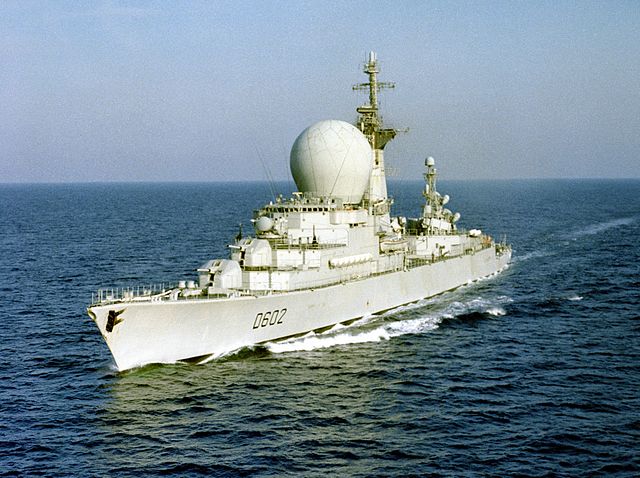
Suffren underway in 1983
In 1982 she took part in celebrities of the “Suffren year” with public relations events organized and was sent to Greece for the common exrcise Phidias and NATO Distant Drum in May, stopping tat Piraeus. She was at the July 14 naval review. In November-December 17 she took part in Exercise Thiof. In Jan-Feb 1983 she took part in Exercise Escaume and until March Exercise Strope, Farfadet in April, and the Inter-allied exercise Distant Drum 83, then Exercise Tercerol, Olifant XIII.
From June to November she was in maintenance, and by November supported the troops engaged in Lebanon (Olifant XIX), stopping at Alexandria, Larnaka.
In 1984, March-May 4 she took part in Mission Olifant XX, Exercise Circe, work with the Fleet Training Center. In June to September she was in repairs following damage to the reduction gears and turbo-pump. In September-November she took part in Mission Mirmillon and in January-February 1985 Exercise Amphora, stopping at Larnaca, Alexandria, Palermo, Volos, Split, Naples, Cádiz, Lisbon, Port Said followed by Ex. Tarot, Distant Hammer, Amphitrite, Farfadet. By October she was in yearly maintenance.
In early 1986 she was commemorating Admiral Suffren at Saint Tropez. In June-July she took part in Exercises Poseidon and Trident, stopping at Patras, Taranto, Palermo and in August Exercise Zinnia, western Mediterranean, stopping in Ajaccio and Valencia, then Exercise Osiris off Alexandria, Friture and Tarot.
In January 1987 she was in ex. Bélénos, central Mediterranean, stopping at Augusta and Naples and by February Exercise Mare Aperto with the Italian Navy, stopping at Livorno, then in March-April Exercise Odysseus and in May Dragon Hammer, in June Armoric, stopping in Valencia, Portsmouth, Casablanca, Ajaccio. In July-November she was in Mission Prometheus, support for the Clemenceau CGB in the Arabian Sea and Gulf of Oman. She went back and returned by December, stopping in Bombay by January 1988.
From June 1988 she was in major maintenance, mid-life overhaul with more than a million hours of work with of modernizations.
Ths concluded in August 1989 followed by trials and refresher cruise, qualifications.
In February-March 1990 she spent time at the Fleet Training Center with Clemenceau and Var. In April-June 15 she taked part in the Héracles mission in the Atlantic with Foch, frigates Montcalm and Aconit, oiler Durance, and exercises with the CBG Ark Royal, CBG USS Kennedy. She also stopped at Punta Delgada, Roosevelt Roads, Les Saintes, Fort-de-France, Iles du Salut, Dakar.
In January 1991 she trained with USS America CBG. At the end of the ultimatum addressed to Iraq for the liberation of Kuwait she stayed in permanent alert.
In April she took part in exercises Friture, passex, Sardinia and on May 7 hosts the First Sea Lord, Admiral Sir Julian Oswald.
In May she takes part to Exercise Dragon Hammer and Ocean Safari, Atlantic, stopping at Lisbon and Alicante.
In she hosts guests from the then Soviet Navy from the cruiser Azov destroyer Krasnyy-Kavkaz while in Toulon.
In October-July 1992 she was in maintenance. In 1992, June 10 the Order of Malta is granted to the Admiral Chief of Staff and Vice-Admiral on board.
After post overhauls trials and time at the Fleet Training Center she escorted the aircraft carrier Clemenceau, frigate La Motte-Picquet, aviso D’Estienne d’Orves and FLM Suffren for the TG with the Italian and Spanish fleets for an ASW week. She took part in Harmonie Sud Est, Tarot 92 carrier strike group exercises.
In January-February 1993 first deployement in the Adriatic for UNPROFOR (operation Osprey) under CTG 470.01, covering Clemenceau and Foudre. By October – November she is detached to the Black Sea, stopping at Istanbul, Varna, Constantza and back to Operation Osprey, stopping in Venice. The operation is reconducted in 1994, cut in April by the Franco-Egyptian Cleopatra exercise. In April-May she took part in Combined Resolute Response and Dynamic Impact exercises and by May-June Inter-allied exercise Iles d’Or 94.
In August she was at the naval review for the 50th anniversary of the Allied landings in Provence, Op. Dragoon.
She spent the winter in maintenance. In September she was at the Naval Action Force training. By October she took part in the Franco-Tunisian Pangolin exercise. By January-February 1996 she is deployed in the Adriatic for Operation Salamandre. By April-May 10 she is in the Franco-Italian-Spanish exercise Eole and first Euromarfor. On June 17 to 21 she takes part in a Franco-American exercise.
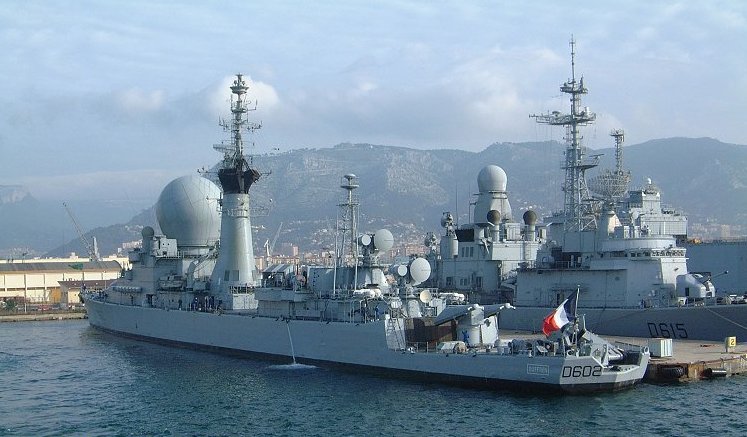
Jan-Feb. 1997 saw her in joint Franco-British and Franco-American exercises. May at the Iles d’Or Exercise and by July to January 1998 she is in Mission Salamander Alert and by September-October she takes part in Exercise Fanfar 97, buy January 1998, Exercise Invitex US 98 and by March Exercise Strong Resolve 98 and Group training of the Safran 1 and 2 Naval Action Force.
In June she taked part in Joint exercise Eole but by September-February 1999 she is Unavailability for maintenance notably asbestos removal.
In Feb. 1999 she is in refit at Toulon. In April 2000 she takes part in Myrrhe mission, Eole exercise in June and presence in the Black Sea. She stopped at Sevastopol with the COS received in an official reception in Ukraine. The ship is open to public.
After a stop in Istanbul she stops in Novorossiyk by September and taked part in a remembrance ceremony for the Kursk, followed by the Cléopatre 2000 exercise.
Suffren, La Motte-Picquet, the oiler Marne, Italian frigates Audace, German Augsburg, takes part from Alexandria in September to the Franco-Egyptian exercise Cleopatra. Later she takes part in the Sarment 2000 exercise and by January 2001 she is in Toulon for a large amphibious exercise, escorting the LSDs Siroco, Foudre, Orage and Ouragan, escorted also by Jean de Vienne and Surcouf, for landings in South Corsica. On April 2, 2001 a commissioned examines her general condition after 36 years of service, 3,079 days at sea, 1,521,492 km crossed, 189 port calls, firing of 104 missiles, 124 torpedoes and 4,353 main arty shells.
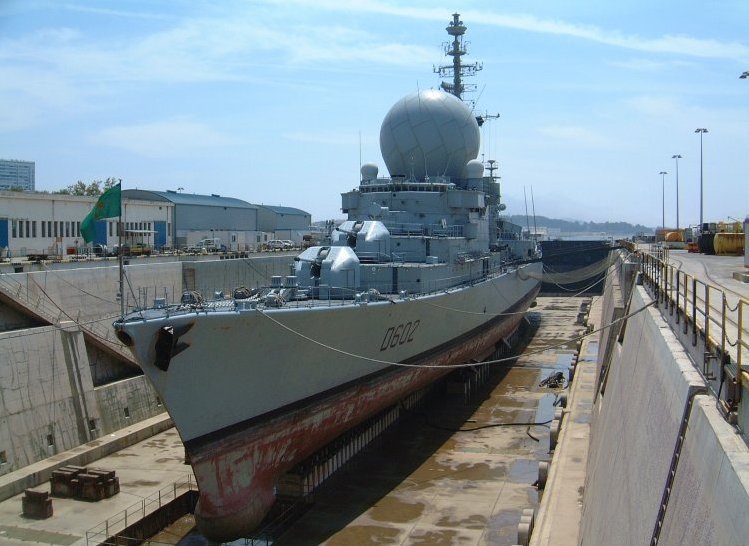
Suffren in Drydock 2001
It is estimated her general states dictates decommission on 2 April 2001, witnessing the first refit of the new aircraft carrier Charles de Gaulle. She is not BU but kept as breakwater in 2009, at Port Avis, where is located the DGA Missile Testing center at the Levant Island. By fall 2023, dismantling is ordered at Gironde Bassens yard, by Vinci group. By 2022 however journalists revealed she was suspected of accidentally shooting down a civilian Caravelle (Air France flight 1611) by missile trial off Cap d’Antibes back in September 11, 1968. As of now, this investigation is still unclosed. The ship is still in scrapping, with the end expected in 2025.
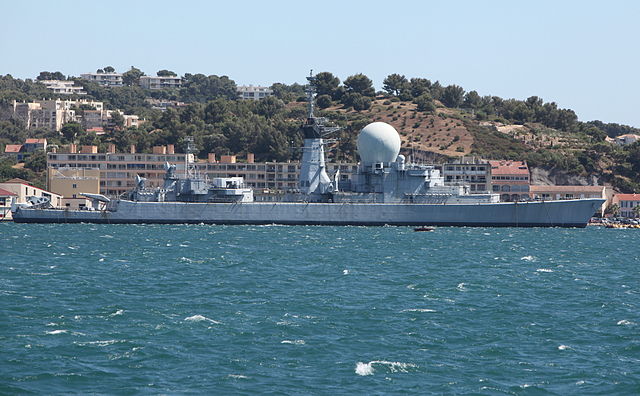
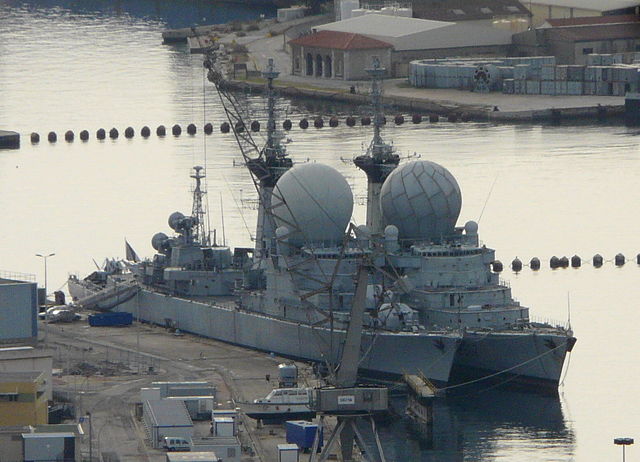
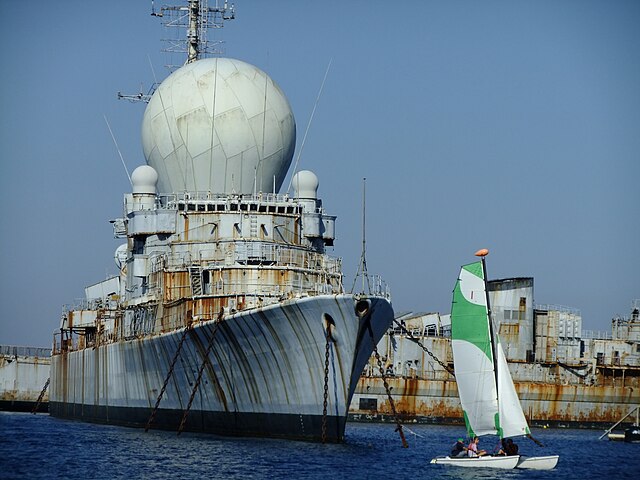
In the mothballs and used as a breakwater at St Mandrier
 FS Duquesne (1970)
FS Duquesne (1970)
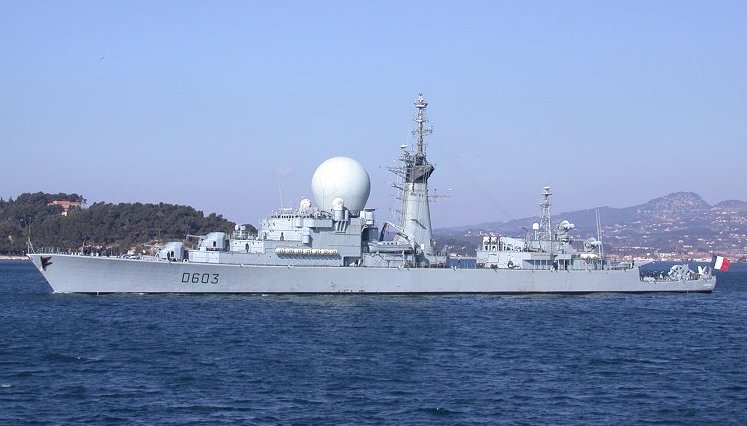
Duquesne was constructed at Lorient Arsenal, laid down in November 1964, launched on 12 February 1966, commissioned on 1 April 1970. Initially based at Brest, Atlantic Fleet she escorted Clemenceau-class aircraft carriers on several deployments. In 1975, when both carriers were transferred to the Mediterranean Fleet, she was reassigned to Toulon from 1977. She was part of the standing fleet off Lebanon from 1982 to 1984 and took part in 1990s operations off former Yugoslavia. In 1992, she joined the Naval Action Force and was retired in 2008, mothballed for a long time, and not scrapped as yet. For more precise logs, see the reference given below from netmarine.
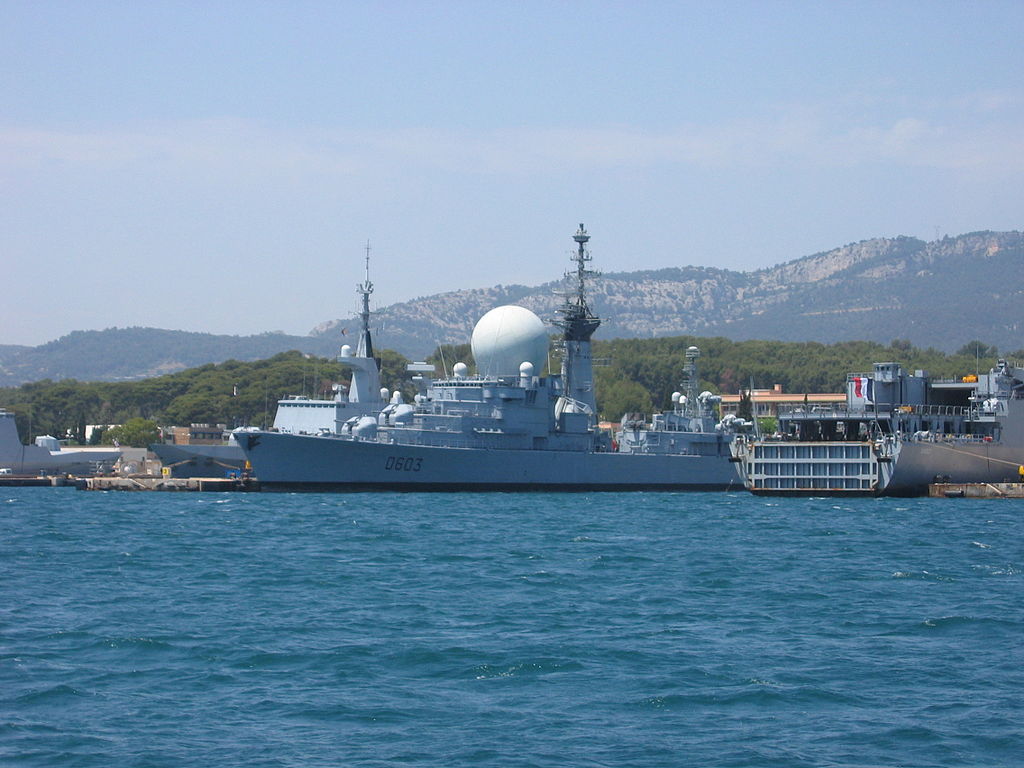
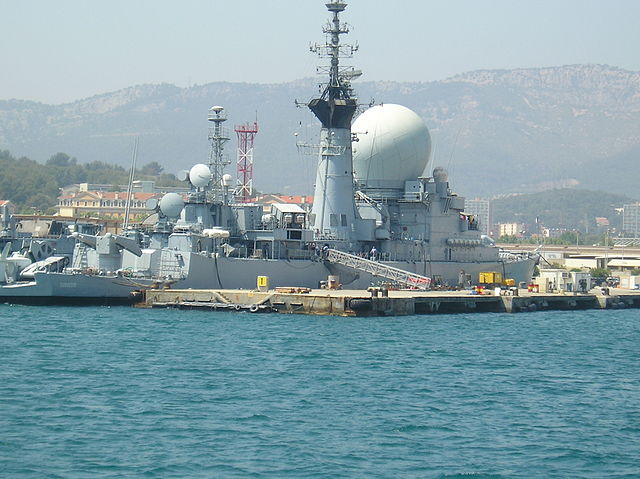
Read More/Src
Books
Jordan, John (1995), Chumbley, Stephen. Conway’s All The World’s Fighting Ships 1947–1995. NIP
Prézelin, Bernard, ed. (1990). The Naval Institute Guide to Combat Fleets of the World 1990/1991 NIP
Saunders, Stephen, ed. (2004). Jane’s Fighting Ships 2004–2005. Jane’s Information Group Inc.
“Les Frégates Suffren et Duquesne” by Jean Moulin, Marines Editions
Links
Full records, Suffren (FR)
netmarine.net duquesne full logs FR
On netmarine.net, portal on the suffren class
Main caracteristics of the class, netmarine
French torpedoes, navweaps.com
navypedia.org/
on en.wikipedia.org/
Masurca
Model Kits
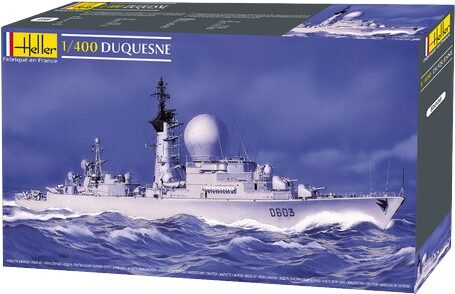
The Heller kit is the only one today, no longer available o the official site, 1:400. Src

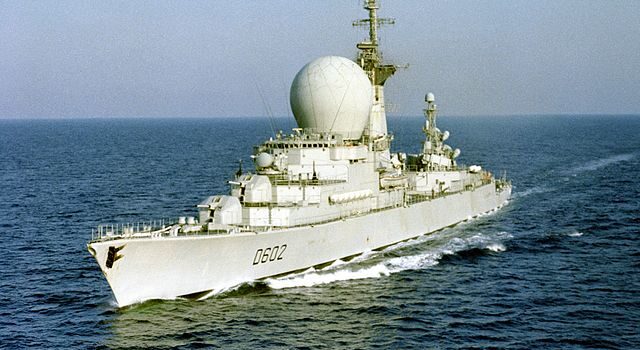
 Latest Facebook Entry -
Latest Facebook Entry -  X(Tweeter) Naval Encyclopedia's deck archive
X(Tweeter) Naval Encyclopedia's deck archive Instagram (@navalencyc)
Instagram (@navalencyc)





 Austrian Navy
Austrian Navy French Navy
French Navy Royal Navy
Royal Navy Armada Espanola
Armada Espanola K.u.K. Kriegsmarine
K.u.K. Kriegsmarine Dansk Marine
Dansk Marine Nautiko Hellenon
Nautiko Hellenon Koninklije Marine 1870
Koninklije Marine 1870 Marinha do Brasil
Marinha do Brasil Osmanlı Donanması
Osmanlı Donanması Marina Do Peru
Marina Do Peru Marinha do Portugal
Marinha do Portugal Regia Marina 1870
Regia Marina 1870 Nihhon Kaigun 1870
Nihhon Kaigun 1870 Preußische Marine 1870
Preußische Marine 1870 Russkiy Flot 1870
Russkiy Flot 1870 Svenska marinen
Svenska marinen Søværnet
Søværnet Union Navy
Union Navy Confederate Navy
Confederate Navy Armada de Argentina
Armada de Argentina Imperial Chinese Navy
Imperial Chinese Navy Marinha do Portugal
Marinha do Portugal Mexico
Mexico Kaiserliche Marine
Kaiserliche Marine 1898 US Navy
1898 US Navy Russkiy Flot
Russkiy Flot French Naval Aviation
French Naval Aviation Russian Naval Aviation
Russian Naval Aviation Sovietskiy Flot
Sovietskiy Flot Royal Canadian Navy
Royal Canadian Navy Royal Australian Navy
Royal Australian Navy RNZN Fleet
RNZN Fleet Chinese Navy 1937
Chinese Navy 1937 Kriegsmarine
Kriegsmarine Chilean Navy
Chilean Navy Danish Navy
Danish Navy Finnish Navy
Finnish Navy Hellenic Navy
Hellenic Navy Polish Navy
Polish Navy Romanian Navy
Romanian Navy Turkish Navy
Turkish Navy Royal Yugoslav Navy
Royal Yugoslav Navy Royal Thai Navy
Royal Thai Navy Minor Navies
Minor Navies Albania
Albania Austria
Austria Belgium
Belgium Columbia
Columbia Costa Rica
Costa Rica Cuba
Cuba Czechoslovakia
Czechoslovakia Dominican Republic
Dominican Republic Haiti
Haiti Hungary
Hungary Honduras
Honduras Estonia
Estonia Iceland
Iceland Eire
Eire Equador
Equador Iran
Iran Iraq
Iraq Latvia
Latvia Liberia
Liberia Lithuania
Lithuania Mandchukuo
Mandchukuo Morocco
Morocco Nicaragua
Nicaragua Persia
Persia San Salvador
San Salvador Sarawak
Sarawak Uruguay
Uruguay Venezuela
Venezuela Zanzibar
Zanzibar Warsaw Pact Navies
Warsaw Pact Navies Bulgaria
Bulgaria Hungary
Hungary

 Bundesmarine
Bundesmarine Dutch Navy
Dutch Navy Hellenic Navy
Hellenic Navy Marina Militare
Marina Militare Taiwanese Navy
Taiwanese Navy Chinese Navy
Chinese Navy Indian Navy
Indian Navy Indonesian Navy
Indonesian Navy JMSDF
JMSDF North Korean Navy
North Korean Navy Philippines Navy
Philippines Navy ROKN
ROKN IDF Navy
IDF Navy Royal New Zealand Navy
Royal New Zealand Navy Egyptian Navy
Egyptian Navy South African Navy
South African Navy

































 RN
RN
 Marine Nationale
Marine Nationale
 Soviet Navy
Soviet Navy
 dbodesign
dbodesign